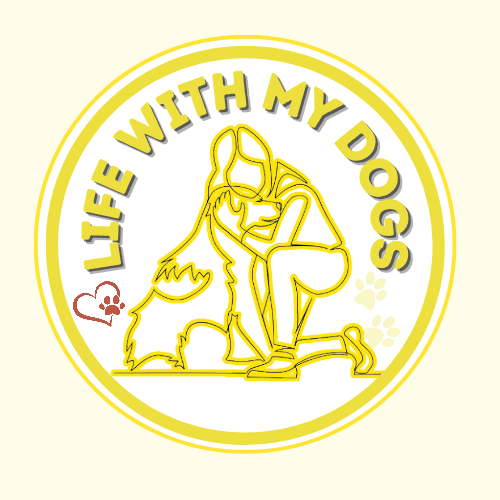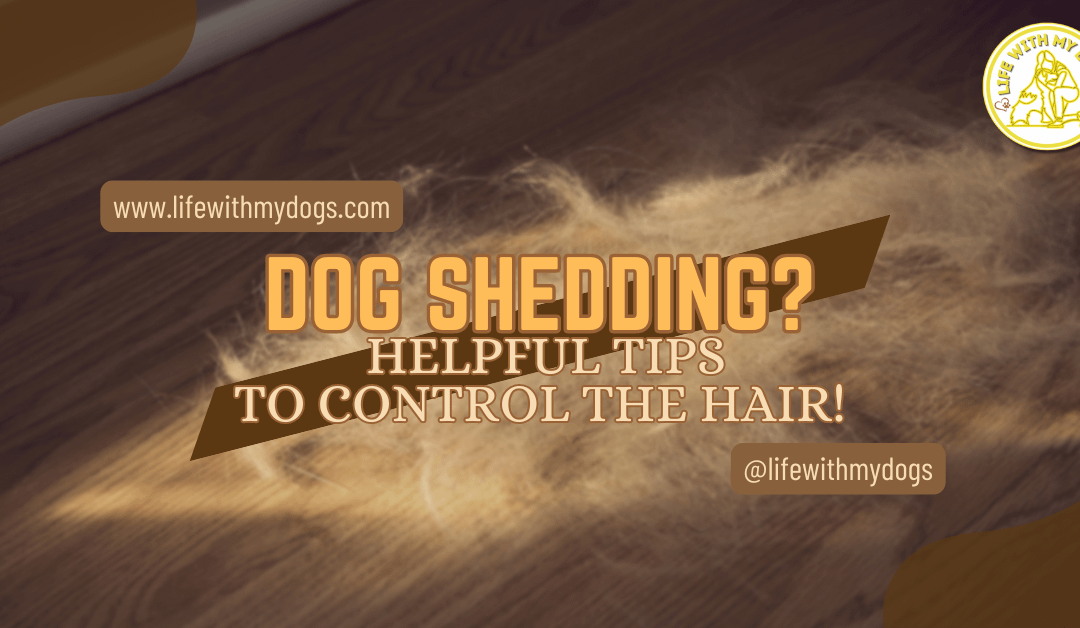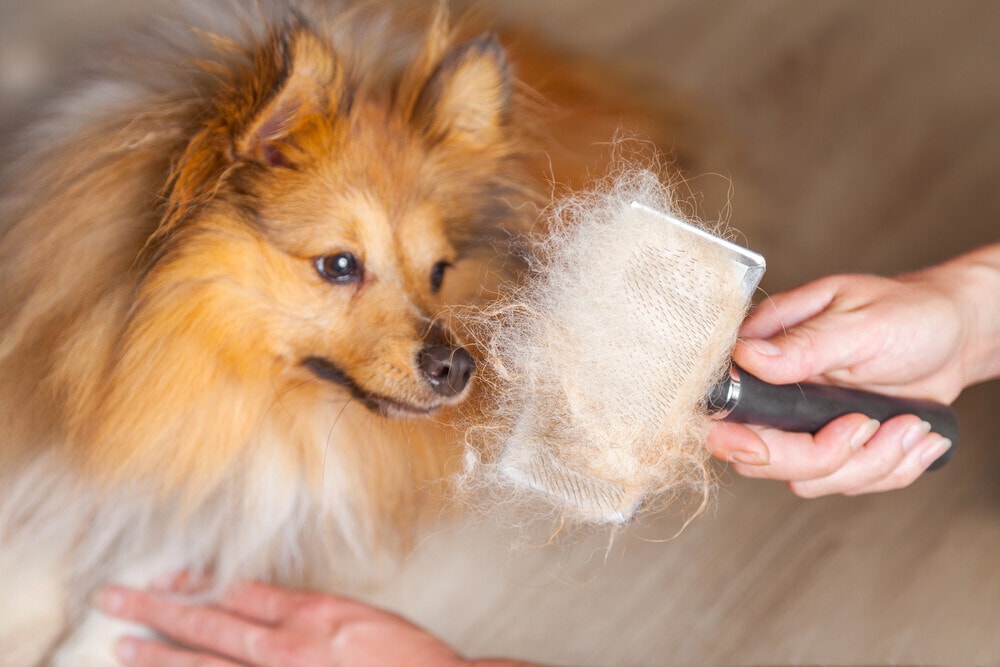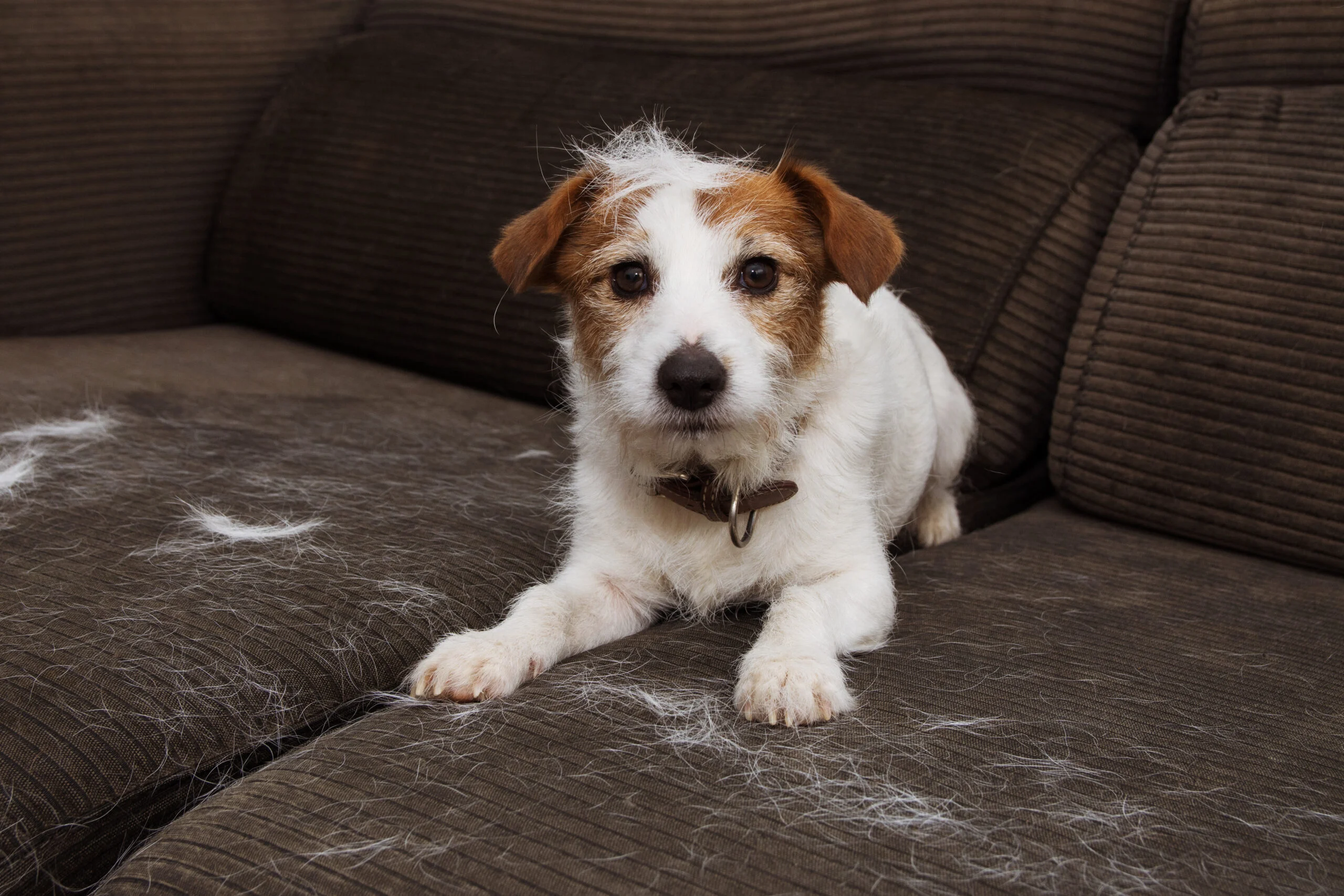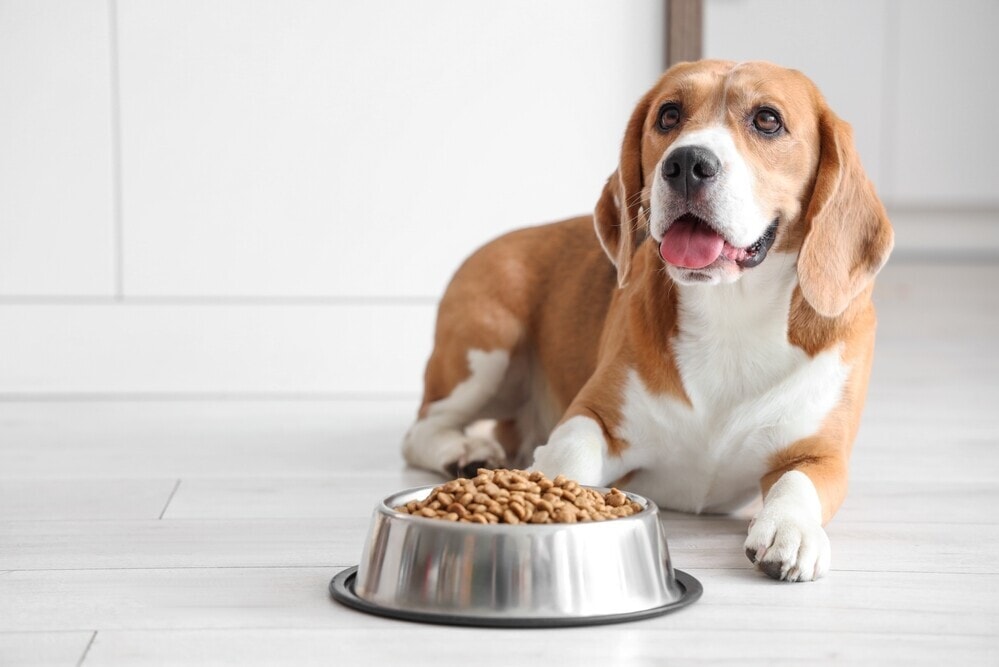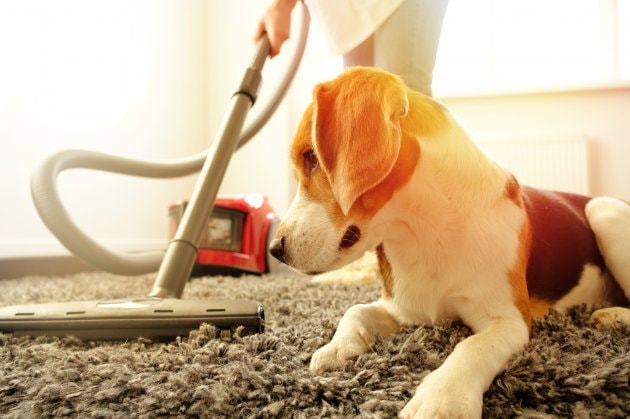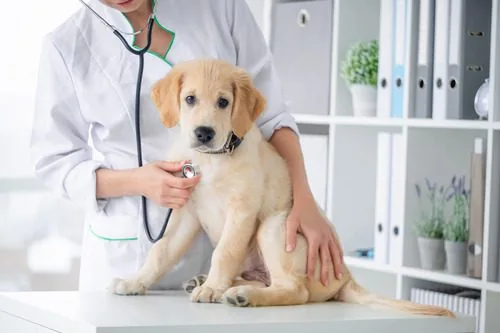LifeWithMyDogs is supported by our audience. When you purchase through one of our links, we may earn a small affiliate commission. As an Amazon Associate I earn from qualifying purchases. Your cost is not affected.
**********
Dog shedding can be one of the most frustrating aspects of owning a pet, with hair seemingly appearing on every surface no matter how often you clean. Shedding can quickly make your home feel unkempt, whether clinging to your furniture and clothes or floating through the air, but controlling the amount of hair your dog sheds doesn’t have to be an impossible task. With the right grooming techniques, proper diet, and a few lifestyle adjustments, you can significantly reduce the amount of loose fur in your home.
This article explores practical tips to help you manage dog shedding and keep your living space tidier. From choosing the best grooming tools to incorporating nutrient-rich foods into your dog’s diet, these practical strategies will help you control the hair and promote a healthier coat for your furry companion. Stick with us, and soon, you’ll discover how to enjoy life with your dog without constantly battling the fur explosion.
Dog Shedding? Helpful Tips to Control the Hair! Easy Tricks for an (Almost) Fur-Free Home
Is your dog leaving fur everywhere? You’re not alone! Many dog owners struggle with dog shedding. I’ve been there too, and I know how frustrating it can be. But don’t worry – there are ways to manage it. Unless you have a non-shedding breed of dog, I won’t promise a fur-free home, but there are ways to help.
Brushing your dog regularly can help reduce shedding by removing loose fur before it falls on your floors and furniture. I’ve found that consistency is key. Even a few minutes of brushing each day can make a big difference. Plus, it’s a great bonding time for you and your furry friend!
Proper nutrition also plays a significant role in coat health. I’ve noticed that feeding my dog a balanced diet with omega-3 fatty acids has helped keep his coat shiny and reduced shedding. It’s amazing how much diet can impact our pets’ overall health, including their fur.
Key Takeaways
- Consistent brushing helps remove loose fur, significantly reducing shedding in your home.
- A balanced diet rich in omega-3 fatty acids promotes a healthy coat and can minimize shedding.
- Shedding varies by season and breed; double-coated breeds often shed more during seasonal changes.
- Frequent vacuuming and using air purifiers can help control pet hair in your living space.
- Regular exercise and a stable routine can reduce anxiety-related shedding in dogs.
Understanding Dog Shedding
Dog shedding is a natural process that helps keep our furry friends’ coats healthy. I’ll explain why dogs shed and how shedding patterns change yearly.
Reasons Dogs Shed
Dogs shed to get rid of old or damaged fur. This process helps them maintain a healthy coat. Some breeds shed more than others due to their coat type. Double-coated breeds like Huskies tend to shed a lot. Diet plays a significant role in shedding, too.
I’ve found that dogs eating high-quality food with good protein and fatty acids often shed less. Stress can also cause extra shedding. When my dog is anxious, I notice more fur around the house. Health issues sometimes lead to unusual shedding. I always check with my vet if I see bald patches or skin problems. It’s important to rule out any medical causes.
Shedding Patterns and Seasons
Most dogs shed year-round, but it often worsens in spring and fall. In spring, dogs lose their winter coats to prepare for warmer weather. Fall shedding helps them grow a thicker coat for winter. I’ve noticed indoor dogs might shed more evenly throughout the year. The steady temperature and lighting can affect their shedding cycle.
Some breeds, like Poodles, shed very little all year. It’s normal for shedding to vary. Puppies shed their soft coat around 4-6 months old. Older dogs might shed more as their skin changes. Female dogs often shed after giving birth or during heat cycles.
Breeds and Shedding Levels
Different dog breeds shed at different rates. Some barely lose hair, while others leave fur everywhere, making dog shedding a common challenge for many pet owners. Let’s look at which breeds shed the least and most, plus tips for managing short and long-haired shedders.
Low-Shedding Breeds
I love low-shedding breeds for their easy maintenance. Poodles are a top choice. Their curly coat traps loose hair so it doesn’t fall out. Schnauzers and Portuguese Water Dogs also shed very little.
Maltese and Bichon Frise are great trim dog options. They have hair that grows continuously, like human hair. This means less shedding but more grooming. Yorkshire Terriers and Shih Tzus are other small breeds with minimal shedding. Their silky coats need regular brushing to prevent mats.
High-Shedding Breeds
I’ve found that some breeds are real fur factories! German Shepherds top the list. They have a thick double coat that sheds year-round, with heavy seasonal shedding. Labrador Retrievers and Golden Retrievers are also significant shedders. Their water-resistant coats shed a lot, especially in spring and fall.
Huskies and Malamutes have dense undercoats. They “blow” their coats twice a year, losing vast amounts of fur. Corgis might be small, but they shed big time. Their thick double coats need frequent brushing to control the hair.
Short Hair Breeds Shedding Problems (Managing the Hair)
I know short-haired breeds can be deceptive. They often shed just as much as long-haired dogs, but the hair is less noticeable. That is until it gets on your clothing and furniture. Brushing regularly is key. I use a rubber curry brush or a hound glove. These tools grab loose hair effectively.
Bathing helps, too. It loosens dead hair. I followed up with a good brushing while the coat was drying. Vacuuming frequently is a must. Short hairs can work their way into fabrics efficiently. Using a deshedding tool once a week can cut down on loose hair.
It reaches the undercoat to remove loose fur before it falls. Keep a lint roller handy to remove these short hairs from clothing and furniture. You will find it quite helpful!
Long Hair Shedding in Big Tufts (Undercoat)
Long-haired dogs with undercoats can shed in massive clumps. I’ve learned some tricks to manage this. Brushing with an undercoat rake is essential. It removes loose undercoat hair before it mats. I use a slicker brush to tackle the outer coat. This prevents tangles and removes loose hair.
During shedding season, I brush daily. It’s the best way to keep on top of the fur. A high-velocity dryer can be a game-changer. It blows out loose undercoat fur after baths. Regular grooming appointments help, too. Pros have tools and techniques to remove undercoats efficiently.
Did You Know?
To effectively prevent dog hair from spreading everywhere, washable dog beds and blankets can help contain the hair in one clean spot. Grooming outdoors, when possible, minimizes hair indoors, and tidying up as grooming occurs makes a difference. Keeping a bag near the grooming area, along with a broom and dustpan, simplifies clean-up. Enlisting a family member can also make it a team effort. Finally, running air purifiers with HEPA filters in commonly used rooms helps capture airborne hair and reduce shedding.
Check out this video on how to stop dog shedding.
By: Ultimate Pet Nutrition
Proper Nutrition for a Healthy Coat
Good food helps dogs have shiny coats and less dog shedding. I’ll tell you about key nutrients and extras that make your pup’s fur look great.
Essential Nutrients
Protein is super important for healthy dog fur. I suggest picking dog food with salmon or fish as the first ingredient. These have omega-3 fatty acids that make coats shiny. Fats are crucial, too. Look for foods with good fats, from fish oil or flaxseed. They help stop dry, itchy skin that leads to more shedding.
Vitamins A and E are great for skin and fur. Zinc and biotin also help. I recommend checking food labels to make sure these are included. Water is often forgotten but so important! I always ensure my dog drinks enough to hydrate his skin and reduce shedding.
Supplements and Treats
Fish oil supplements can boost coat health. I give my dog a daily dose to keep his fur soft and reduce shedding. Coconut oil is another excellent option. It moisturizes skin and can help with shedding when added to food or rubbed on the coat. Omega-3 chews are tasty treats that also improve coat health. My dog loves them, and I’ve noticed less fur around the house.
Some dogs benefit from probiotics. They can help with skin issues that cause excess shedding. I sometimes mix a probiotic powder into my dog’s food. Remember, your vet should okay any new supplements first. They can help you pick the right ones for your pup’s needs.
Grooming Techniques
Keeping your coat in top shape is key to managing dog shedding. I’ve found some great ways to control loose hair through regular care and grooming.
Regular Brushing
I brush my dog’s coat every few days to remove loose fur. This helps stimulate hair follicles for a healthier coat. I use a brush suited for my dog’s hair type. Short-haired dogs do well with rubber curry brushes. For long-haired pups, I prefer slicker brushes to detangle.
I brush in the direction of hair growth, being gentle around sensitive areas. This relaxing routine strengthens our bond, too. Regular brushing spreads natural oils through the coat. This keeps my dog’s skin moisturized and reduces itching.
Bathing Your Dog
I bathe my dog every 4-8 weeks to control shedding. More frequent baths can dry out the skin. I use a mild dog shampoo and rinse thoroughly. Any leftover soap can irritate the skin. After bathing, I towel dry and use a blow dryer on low heat. This helps remove loose fur. I brush while drying to catch extra hair. A clean, well-groomed coat sheds less between baths.
Professional Grooming Tips
I take my dog to a pro groomer when I can’t manage at home. They have the tools and skills to tackle heavy shedding. Groomers can do a deep clean with special deshedding shampoos. They also use high-velocity dryers to blast out loose fur.
I ask for a deshedding treatment that removes the undercoat without damaging the topcoat. Groomers can spot skin issues I might miss. They give great advice on maintaining my dog’s coat between visits. Regular pro grooming keeps shedding under control, and my dog looks great.
Home Cleaning Strategies
Keeping your home clean with dog shedding can be a challenge. I’ve found great ways to manage all that fur and tidy things.
Frequent Vacuuming
I vacuum often – at least 2-3 times a week. It helps control the fur. I use a vacuum designed for pet hair with solid suction and special attachments. For hard floors, I sweep first to gather loose fur.
Then, I vacuum to get anything left behind. On carpets, I go over high-traffic areas multiple times. I don’t forget places like under furniture and along baseboards. That’s where fur tends to collect. A handheld vacuum is great for stairs and tight spots.
Air Purification
An air purifier helps remove fur and dander from the air. I place one in rooms where my dog spends the most time. I look for cleaners with HEPA filters. These catch tiny particles like pet dander. Some even have unique pet modes. Changing the filter regularly is key. A clogged filter won’t work well. I also dust and vacuum near the cleaner to help it run better.
Furniture and Bedding Care
I use washable covers on couches and chairs. Tossing these in the wash is easier than cleaning the whole piece of furniture. We have a double cover on our sofa and loveseat. The outer is an extra large blanket that covers a waterproof fitted cover.
Why the two? The waterproof fit is very functional but less comfortable. The blanket is more relaxed and very easy to throw in the wash. We have an extra set of blankets, so we can use one while washing the other.
For beds, I use a pet-friendly detergent when washing sheets and blankets. This helps break down oils from pet fur. I keep a lint roller handy for quick touch-ups on fabric surfaces. I use a slightly damp microfiber cloth to pick up fur for wooden furniture. Grooming my dog regularly also helps reduce the amount of loose fur around the house.
Controlling Shedding With Lifestyle Changes
I’ve found that making simple changes to your dog’s routine can help cut down on dog shedding. Let’s look at how exercise and stress affect your pup’s hair loss.
Exercise and Its Effects
I’ve noticed that dogs with plenty of exercise tend to shed less. Regular walks and playtime keep your dog’s circulation going strong. This helps distribute natural oils through their coat, leading to healthier fur. I recommend aiming for at least 30 minutes of activity each day. This could be:
- A brisk walk around the neighborhood
- A game of fetch in the backyard
- A trip to the dog park
Exercise also helps reduce stress, which brings me to my next point.
The Impact of Stress
I’ve seen firsthand how stress can make shedding worse. When dogs feel anxious or upset, they often lose more fur than usual. To help keep stress levels down, I suggest:
- Sticking to a consistent daily routine
- Providing a quiet, comfortable space for your dog
- Using calming aids like puzzle toys or soothing music
I’ve found that regular brushing can be relaxing for many dogs, too. It’s a great way to bond and can help reduce anxiety-related shedding.
When to See a Veterinarian
Excessive dog shedding can sometimes signal health problems in dogs. I’ll share signs to watch for and potential issues requiring a vet visit.
Signs of Excessive Shedding
I’ve seen many cases of normal shedding, but some signs point to a problem. Bald patches or thinning fur are red flags. I get concerned if I notice my dog’s coat looking dull or dry. Skin irritation, redness, or scabs can also mean trouble.
I keep an eye out for my dog scratching more than usual. Shedding that suddenly increases or continues year-round may need checking. I always pay attention if I see clumps of fur falling out.
Potential Health Issues
When I spot those signs, I think about possible health problems. Allergies can cause excessive shedding in dogs. I’ve learned that food sensitivities or environmental triggers may be to blame. Hormone imbalances like hypothyroidism can affect a dog’s coat. Parasites such as fleas or mites are another culprit I consider.
Stress or anxiety might lead to more shedding, too. I watch for other behavior changes that could point to this. Rarely, excessive shedding can signal more serious issues like autoimmune diseases. That’s why I don’t hesitate to consult my vet if I’m worried.
Check out this video on the reasons for hair shedding in dogs and learn how to stop excessive shedding.
By: Monkoodog
Final Thoughts on Managing Dog Shedding: Effective Strategies for a Fur-Free Home
Managing dog shedding is a common challenge for pet owners, but it’s also a manageable one. By implementing regular grooming practices, providing a nutritious diet, and maintaining a clean living environment, owners can significantly reduce the amount of fur in their homes. Additionally, understanding the shedding patterns associated with different breeds can help owners tailor their approach to better suit their dog’s needs, resulting in a happier pet and a cleaner space.
With these tips and tricks, dog owners can navigate the shedding season with confidence. Regular brushing, proper nutrition, and a consistent cleaning routine not only keep loose fur at bay but also promote a healthy coat for your furry friend. By incorporating these strategies, owners can foster a loving and comfortable environment while minimizing the frustration that comes with shedding. With dedication and care, managing dog hair can become a seamless part of pet ownership, allowing for a harmonious coexistence with our canine companions.
